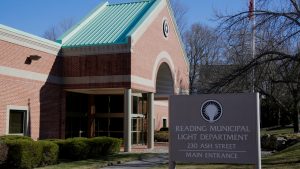Reading, MA — The Reading Municipal Light Department’s (RMLD’s) Citizens’ Advisory Board (CAB) and Board of Commissioners (Board) approved a rate increase effective January 1, 2022. As a not-for-profit entity, the rates support the operating cost of the utility. The CAB and Board also approved RMLD’s 2022 Capital Budget and Operations Budget.

Average monthly bills during 2022 are estimated to increase for each rate class: 4.7% for residential customers, 4.3% for residential time-of-use customers, 3.9% for commercial customers, 3.7% for industrial time-of-use customers, and 2.2% for schools.
As an example, an average residential customer uses approximately 800-kilowatt hours (kWh) per month and can expect their monthly bill to increase by approximately $5.81, which is a 4.7% increase. Example bills for all rate classes and additional discussion can be found on the RMLD website, please visit https://www.rmld.com/home/pages/discussion-2022-rate-changes.
The rate change follows the completion of the 2021 Class Cost of Service (CCOS) study and subsequent rate analysis, the results of which were presented to the Board of Commissioners and Citizens’ Advisory Board in an open meeting held on August 12, 2021. A CCOS study is conducted every three years to evaluate the actual cost of providing service to each of the rate classes, and to adjust rates to fairly allocate costs across rate classes, in compliance with regulations.
In March 2021, Massachusetts passed comprehensive climate legislation, An Act Creating a Next Generation Roadmap for Massachusetts Climate Policy (also referred to as the Climate Bill), which sets several compliance standards for Massachusetts Municipal Light Plants (MLPs). The RMLD 2022 rate increases are driven by the Climate Bill mandate to reduce emissions in the utility, building, and transportation sectors by shifting from fossil fuels and towards non-carbon electricity, which aligns with the goal of electrification. The rate increase supports accelerating upgrades to RMLD’s local distribution system (wires, poles, transformers, etc.) to handle higher electricity loads and peak demand as customers electrify their homes and businesses in an effort to align with the mandated Climate Bill goals. The Efficiency Electrification Charge (EEC, formerly Energy Conservation Charge (EEC)) is also increasing from $0.001/kWh to $0.003/kWh to provide more customer rebates and incentives.
The Climate Bill establishes first-time compliance mandates for Municipal Light Plants (MLPs), requiring that the power sold by MLPs be sourced from resources that are 50% non-carbon by 2030, 75% non-carbon by 2040, and net-zero carbon by 2050 – this is expected to impact power supply costs, and therefore, monthly customer bills, in the future.
RMLD’s rates are approximately 30-35% lower than Investor Owned Utilities in Massachusetts.
The CAB and Board also approved two new rate offerings. The first is an opt-in Renewable Choice Program for customers who choose to purchase renewable/non-carbon power above RMLD’s Policy 30 goals and Climate Bill compliance targets. The second is a new residential Time-of-Use rate (A3) offering three pricing tiers and targeted towards customers who charge an electric vehicle at their home and/or those who wish to shift electricity usage to off-peak hours for potentially significant savings. Additional details and program logistics will be provided on the RMLD website, rmld.com.
